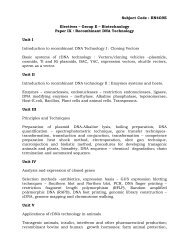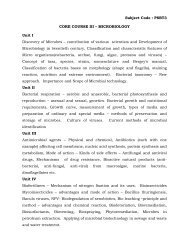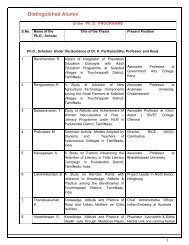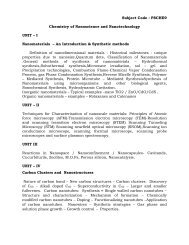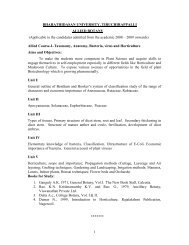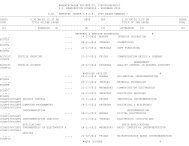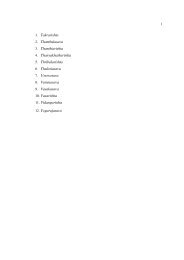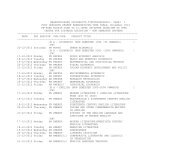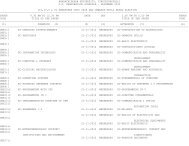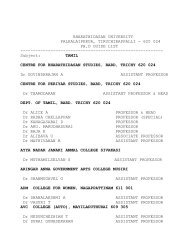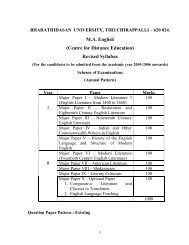05 Cereal and Jaggery based beverage
05 Cereal and Jaggery based beverage
05 Cereal and Jaggery based beverage
You also want an ePaper? Increase the reach of your titles
YUMPU automatically turns print PDFs into web optimized ePapers that Google loves.
V. <strong>Cereal</strong> <strong>and</strong> jaggery <strong>based</strong> <strong>beverage</strong><br />
Daru<br />
Place of origin/usage: Uttaranchal.<br />
Nature of <strong>beverage</strong>: <strong>Cereal</strong> <strong>and</strong> jaggery <strong>based</strong>.<br />
Usual composition/ingredients: Rice <strong>and</strong> jaggery are the common substrate used for<br />
preparation of daru in addition to starter material (Balam – see the chapter ‘Prepared<br />
Starter for fermented country <strong>beverage</strong> production’). Apart from rice, the cereals like<br />
Setaria italica (koni), Amaranthus paniculatus (chuwa), Hordeum himalayens (oowa) <strong>and</strong><br />
wheat are used in the preparation of daru. The taste (i.e. quality) of the daru does not vary<br />
according to the type of substrate used.<br />
Method of preparation: Cooked rice on becoming cool is mixed with the powder of balam.<br />
This mixture is then kept in an airtight container for fermentation <strong>and</strong> is kept in preferably<br />
a warmer place. To ensure the warmth, the fermentation container is covered with woolen<br />
cloth or else it is kept near the cooking hearth. However, direct heating is avoided. After<br />
about a week of fermentation, when the mixture is in a semi liquid condition, it is distilled<br />
in a distillation vessel. The distillate substance is the daru, which is collected in bottles.<br />
The undigested residue is called chak, is dirty white in colour, which can be used again for<br />
preparation of daru by fortification with jaggery <strong>and</strong> fresh balam powder. This way chak is<br />
recycled or reused in daru preparation.<br />
Method of distillation <strong>and</strong> consumption: In the traditional distillation method, the<br />
indigenous set, which is quite simple, has three parts parar, jokhal <strong>and</strong> tal, as called in the<br />
local dialect. The parar is a big saucepan like container with flat bottom, <strong>and</strong> jokhal is a<br />
flat wooden device like a dish having an elongated channel with a hole at the center. The<br />
tal is a simple cooking vessel, but the neck of tal <strong>and</strong> the bottom of parar is of such a size<br />
that they hold the jokhal perfectly. This whole system is put on fire, on being heated the<br />
alcoholic vapor first evaporate <strong>and</strong> come through the central hole of the jokhal. But on<br />
coming in contact with cold bottom of parar the vapor gets condensed into liquid. This<br />
liquid is collected in a container <strong>and</strong> this distillate is the alcohol or daru.<br />
The daru collected in first three to four bottles during the process of distillation<br />
contains very high percentage of alcohol <strong>and</strong> is always diluted before consumption. The<br />
1
alcohol content gradually reduces <strong>and</strong> finally only water evaporates. Traditionally daru is<br />
graded into three categories the initial few bottles containing high percentage of alcohol is<br />
called paileful; the final few bottles containing very low contents of alcohol is called<br />
piskani, <strong>and</strong> a few bottles in between them containing moderate contents of alcohol is rated<br />
good for consumption. For making the daru attractive in appearance, a small quantity of<br />
turmeric is hanged right at the mouth of the distillation set through which the distillate is<br />
collected. This makes the liquid a light but brilliantly shining yellow in colour.<br />
Nature of fermentation: Alcoholic fermentation.<br />
Whether native fermentation or inoculum (starter) is added: Inoculum in the form of<br />
starter ‘Balam’is added.<br />
Other applications: Chak (undigested residue) is recycled or reused in daru preparation.<br />
However, this is not used for more than three times, <strong>and</strong> used as feed.<br />
Varied/ Related forms of <strong>beverage</strong>: Jann.<br />
Reference(s): Roy et al., 2004.<br />
2



